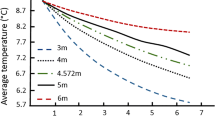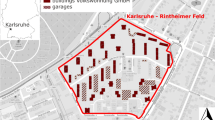Abstract
Shallow geothermal heat has the characteristics of wide distribution and huge reserves. However, for northern rural buildings, the heating load in winter is much greater than the cooling load in summer, and thermal imbalance of the soil is prone to occur. This paper takes rural residences in southern Hebei as an example and designs a solar-assisted shallow geothermal energy system. Compared with the original shallow ground-source heat pump system, the indoor and outdoor temperature differences of the target building were first analyzed. Second, the changes in the soil temperature field and the differences in the supply and return water temperature were monitored. Finally, the initial investment and operating costs of the assisted system are analyzed. The results show that the average ground temperature field increases significantly in winter. Through the alternate operation of solar energy and ground-source heat pumps, heat extraction from the ground is reduced, and the imbalance cycle of heat extraction in winter and heat removal in summer is shortened. It alleviates the imbalance of the cold and heat loads for soil throughout the year. The inlet and outlet water temperature and heat exchange efficiency of the buried pipes have been significantly improved. The energy efficiency ratio of the system using the assisted system has increased from 3.40 in 2020 to 4.17, an increase of 0.77. The optimal ratio of the solar- assisted shallow geothermal energy system is a 12.80 m2 solar heat-collection area and one buried hole. The winter heating operating cost of the solar-assisted shallow geothermal energy system is 18.86 CNY/m2. It can save 37% of the annual operating costs of heating, cooling, and hot water compared to a single ground-source heat pump system and 40%–45% compared to traditional heating and cooling modes.
Similar content being viewed by others
References
International Energy Agency (IEA). World energy outlook 2021. 2021. https://www.iea.org/reports/world-energy-outlook-2021.
Opeyemi B M. Path to sustainable energy consumption: The possibility of substituting renewable energy for non-renewable energy[J]. Energy, 2021, 228: 120519.
Smirnova E, Kot S, Kolpak E, et al. Governmental support and renewable energy production: A crosscountry review[J]. Energy, 2021, 230: 120903.
Noorollahi Y, Saeidi R, Mohammadi M, et al. The effects of ground heat exchanger parameters changes on geothermal heat pump performance-A review[J]. Applied Thermal Engineering, 2018, 129: 1645–1658.
Noorollahi Y, Arjenaki H G, Ghasempour R. Thermoeconomic modeling and GIS-based spatial data analysis of ground source heat pump systems for regional shallow geothermal mapping[J]. Renewable and Sustainable Energy Reviews, 2017, 72: 648–660.
Heidarinejad G, Rayegan S, Pasdarshahri H. Dynamic simulation of a solar desiccant cooling system combined with a ground source heat exchanger in humid climates[J]. Journal of Building Engineering, 2020, 28: 101048.
Li H, Bi Y, Qin L, et al. Absorption solar-ground source heat pump: Life cycle environmental profile and comparisons[J]. Geothermics, 2020, 87: 101850.
Martinopoulos G, Papakostas K T, Papadopoulos A M. A comparative review of heating systems in EU countries, based on efficiency and fuel cost[J]. Renewable and Sustainable Energy Reviews, 2018, 90: 687–699.
Li R, Ooka R, Shukuya M. Theoretical analysis on ground source heat pump and air source heat pump systems by the concepts of cool and warm exergy[J]. Energy and Buildings, 2014, 75: 447–455.
Penrod E B, Prasanna K V. Design of a flat-plate collector for a solar earth heat pump[J]. Solar Energy, 1962, 6(1): 9–22.
Penrod E B. Solar load analysis by use of orthographic projections and spherical trigonometry[J]. Solar Energy, 1964, 8(4): 127–133.
You T, Wu W, Shi W, et al. An overview of the problems and solutions of soil thermal imbalance of ground-coupled heat pumps in cold regions[J]. Applied Energy, 2016, 177: 515–536.
Abdel-Salam M R H, Zaidi A, Cable M. Field study of heating performance of three ground-source heat pumps in Canadian single-family houses[J]. Energy and Buildings, 2021, 247: 110959.
Naranjo-Mendoza C, Oyinlola M A, Wright A J, et al. Experimental study of a domestic solar-assisted ground source heat pump with seasonal underground thermal energy storage through shallow boreholes[J]. Applied Thermal Engineering, 2019, 162: 114218.
Girard A, Gago E J, Muneer T, et al. Higher ground source heat pump COP in a residential building through the use of solar thermal collectors[J]. Renewable energy, 2015, 80: 26–39.
Lee M, Ham S H, Lee S, et al. Multi-objective optimization of solar-assisted ground-source heat pumps for minimizing life-cycle cost and climate performance in heating-dominated regions[J]. Energy, 2023, 270: 126868.
Bakirci K, Ozyurt O, Comakli K, et al. Energy analysis of a solar-ground source heat pump system with vertical closed-loop for heating applications[J]. Energy, 2011, 36(5): 3224–3232.
Kjellsson E, Hellström G, Perers B. Optimization of systems with the combination of ground-source heat pump and solar collectors in dwellings[J]. Energy, 2010, 35(6): 2667–2673.
Sakellariou E I, Axaopoulos P J. Energy performance indexes for solar assisted ground source heat pump systems with photovoltaic-thermal collectors[J]. Applied Energy, 2020, 272: 115241.
Emmi G, Zarrella A, De Carli M, et al. An analysis of solar assisted ground source heat pumps in cold climates[J]. Energy Conversion and Management, 2015, 106: 660–675.
Sakellariou E I, Axaopoulos P J, Wright A J. Energy and economic evaluation of a solar assisted ground source heat pump system for a north Mediterranean city[J]. Energy and Buildings, 2021, 231: 110640.
Qi Z, Cai Y, Cui Y. Study on optimization of winter operation characteristics of solar-ground source heat pump in Shanghai[J]. Renewable Energy, 2023: 119517.
Zhang X, Wang E, Liu L, et al. Analysis of the operation performance of a hybrid solar ground-source heat pump system[J]. Energy and Buildings, 2022, 268: 112218.
Chen Y, Chen Z, Chen Z, et al. Dynamic modeling of solar-assisted ground source heat pump using Modelica[J]. Applied Thermal Engineering, 2021, 196: 117324.
Sun T, Yang L, Jin L, et al. A novel solar-assisted ground-source heat pump (SAGSHP) with seasonal heat-storage and heat cascade utilization: Field test and performance analysis[J]. Solar Energy, 2020, 201: 362–372.
Zhang C, Nielsen E, Fan J, et al. Experimental investigation on a combined solar and ground source heat pump system for a single-family house: Energy flow analysis and performance assessment[J]. Energy and Buildings, 2021, 241: 110958.
Si Q, Okumiya M, Zhang X. Performance evaluation and optimization of a novel solar-ground source heat pump system[J]. Energy and Buildings, 2014, 70: 237–245.
Yang W, Zhang H, Liang X. Experimental performance evaluation and parametric study of a solar-ground source heat pump system operated in heating modes[J]. Energy, 2018, 149: 173–189.
Yang W, Sun L, Chen Y. Experimental investigations of the performance of a solar-ground source heat pump system operated in heating modes[J]. Energy and Buildings, 2015, 89: 97–111.
Bi Y, Guo T, Zhang L, et al. Solar and ground source heat-pump system[J]. Applied Energy, 2004, 78(2): 231–245.
Chen P, Xu Y, Ning H, et al. Performance of a solar ground source heat pump used for energy supply of a separated building[J]. Geothermics, 2022, 105: 102524.
Ruoping Y, Xiangru Y, Xiaohui Y, et al. Performance study of split type ground source heat pump systems combining with solar photovoltaic-thermal modules for rural households in North China[J]. Energy and Buildings, 2021, 249: 111190.
Dai L, Li S, DuanMu L, et al. Experimental performance analysis of a solar assisted ground source heat pump system under different heating operation modes[J]. Applied Thermal Engineering, 2015, 75: 325–333.
Zheng Z, Zhou J, Yang Y, et al. Performance analysis of a novel solar assisted ground source heat pump water heating system with graded thermal energy storage[J]. Energy Conversion and Management, 2023, 288: 117179.
Li Y, Bi Y, Lin Y, et al. Analysis of the soil heat balance of a solar-ground source absorption heat pump with the soil-based energy storage in the transition season[J]. Energy, 2023, 264: 126394.
Ministry of housing and urban rural development of the people’s republic of China. GB50366-2009-Technical code for ground-source heat pump system. 2009.
Acknowledgments
Thanks for the support of the project of Shallow geothermal energy + Research and demonstration of combined utilization of solar energy (13000021GLN70RYZ3AACF). The work described in this paper was sponsored by the Natural Science Foundation of Hebei Province (E2023402072).
Author information
Authors and Affiliations
Corresponding authors
Additional information
Wang Xu, engineer. His main research interests include the investigation and evaluation of geothermal resources and shallow geothermal energy.
Bao Ling-Ling, doctor, professor. She graduated from Tianjin University with a Ph.D. and worked as a visiting scholar at the Hong Kong Polytechnic University. She is currently working at the School of Energy and Environmental Engineering at Hebei University of Engineering. She is mainly engaged in mid-deep geothermal utilization theory and technology, low-grade thermal energy utilization technology, heat and mass transfer theory and application.
Rights and permissions
About this article
Cite this article
Wang, HM., Li, JW., Jia, WG. et al. Analysis of the operation characteristics of solar-assisted shallow geothermal energy systems in rural residential areas in southern Hebei Province. Appl. Geophys. (2024). https://doi.org/10.1007/s11770-024-1051-5
Received:
Revised:
Published:
DOI: https://doi.org/10.1007/s11770-024-1051-5




